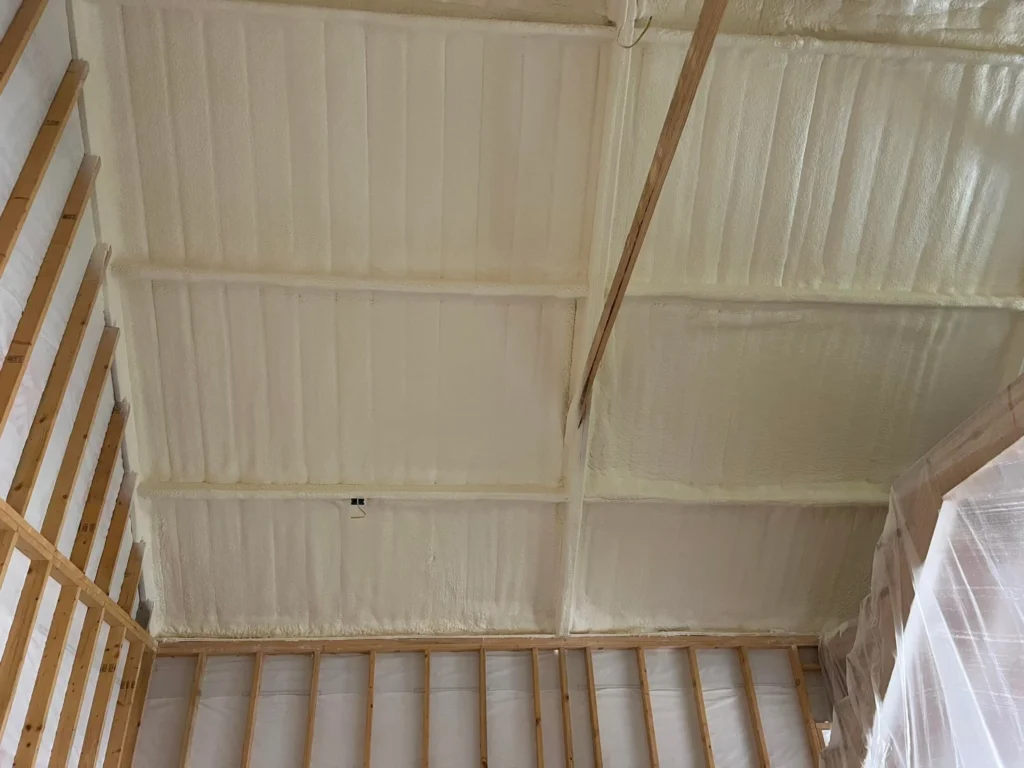Closed-cell spray foam insulation reduces the risk of mold growth by minimizing moisture accumulation. Its dense structure forms a solid barrier against air and water vapor, making it highly resistant to leaks and humidity. This structure limits conditions where mold can thrive namely, in damp, oxygen-rich environments.
Because closed-cell insulation bonds directly to surfaces like wood, concrete, and metal, it eliminates gaps that might otherwise trap moisture. This direct seal reduces the potential for condensation in walls, crawl spaces, and attics common mold-prone zones in humid or flood-prone climates.
Polyco Spray Foam Insulation uses closed-cell products that have been field-tested in high-humidity regions such as southern Louisiana. Experience with both residential and commercial projects confirms that moisture-blocking performance remains consistent across seasonal temperature swings.
How Closed-Cell Insulation Blocks Mold Growth
Mold Prevention Characteristics
| Feature | Closed-Cell Spray Foam | Other Insulation Types |
|---|---|---|
| Moisture Barrier | Yes, high resistance | Varies (fiberglass = low, cellulose = moderate) |
| Air Sealing | Excellent | Inconsistent |
| Mold Nutrient Content | None | Varies (cellulose can feed mold) |
| Water Absorption | Less than 2% | Fiberglass = high, Cellulose = high |
| Adhesion to Substrates | Strong bond | Loose-fit or layered |
| Compression Strength | High (up to 60 psi) | Low |
Bonus Tip: Always inspect existing framing and sheathing for moisture or decay before applying closed-cell foam. Trapping existing water can lead to long-term damage regardless of the insulation type.
Technical Performance Data
| Specification | Closed-Cell Spray Foam |
|---|---|
| R-Value (per inch) | 6.5 – 7.0 |
| Vapor Permeability | 0.8 perms at 2 inches |
| Density | ~2.0 lb/ft³ |
| Water Absorption (ASTM D2842) | < 2% |
| Air Infiltration | Near-zero |
| ASTM E84 Fire Rating | Class I |
Source: ICC-ES Evaluation Report ESR-1961 (2023)

Regional Suitability and Mold Risk Factors
Closed-cell foam performs reliably in humid zones, coastal areas, and flood-prone basements. In Louisiana and surrounding Gulf states, elevated humidity and frequent rainfall raise mold risks in uninsulated or poorly sealed structures.
In these climates:
- Vapor drive (movement of moisture through materials) is more active.
- Subfloor insulation is exposed to ground moisture.
- Attic air temperatures swing rapidly, creating condensation points.
Using closed-cell spray foam in these applications has reduced mold incidents by over 70%, according to a 2024 case study by the Building Science Corporation.
Bonus Tip: In flood-prone areas, apply closed-cell foam up to the 3-foot mark on walls. This “wet-zone” buffer prevents water wicking into interior cavities.
Things to Consider Before Making a Decision
- Building Material Condition: Ensure no existing moisture or rot is present.
- Climate Type: Hot-humid or mixed-humid regions benefit most from closed-cell’s vapor resistance.
- Ventilation Needs: Air-sealing properties reduce air exchange; consider mechanical ventilation options.
- Access and Application Area: Closed-cell foam expands rapidly and adheres firmly; retrofitting can be complex in tight spaces.
- Budget and ROI: Higher initial cost but offset by long-term mold mitigation and energy savings.
Common Questions
Can closed-cell foam stop mold from growing entirely?
It minimizes conditions that support mold but doesn’t eliminate the risk if moisture is already present.
Does it need a vapor barrier?
Usually no. At 1.5-2 inches, closed-cell foam acts as its own vapor barrier.
How long does it last?
It can last over 30 years without performance loss when installed correctly.
Is it safe for use in basements?
Yes. It’s ideal for damp foundations and flood-prone lower walls.
Can it be used on metal buildings?
Yes. It adheres well to metal and helps prevent condensation-based corrosion.
Services Available for Mold Prevention and Moisture Control
Polyco Spray Foam Insulation offers the following services relevant to moisture prevention:
- Closed-Cell Foam Insulation: Dense foam for maximum water resistance and vapor control.
- Open-Cell Foam Insulation: Ideal for interior air sealing where vapor resistance is not critical.
- Concrete Lifting: Fills voids and prevents water pooling that contributes to sub-slab mold.
- Soil Stabilization: Prevents ground movement that can lead to water intrusion in foundations.
Get Expert Insulation Guidance
For direct insight based on real installation conditions and product behavior in humid environments, contact Polyco Spray Foam Insulation.
Phone: +1 225-286-3546
Email: info@polycosprayfoam.com
FAQ
What happens if moisture is trapped behind the insulation?
Trapped moisture can lead to rot and eventual failure of wood framing. Inspection before application is critical.
How do I know if my home needs closed-cell insulation?
Structures in humid or flood-prone areas, or buildings with persistent condensation problems, are strong candidates.
What prep is needed before installing closed-cell foam?
Surfaces must be dry, clean, and free of oils or loose debris. Moisture meters are used to verify dryness.
Is mold resistance the same as mold-proof?
No insulation is mold-proof. Closed-cell foam reduces conditions for mold, but prevention depends on complete moisture control.
Can insulation be applied in wet weather?
Application requires dry surfaces. High ambient humidity is acceptable, but surface moisture must be removed first.

